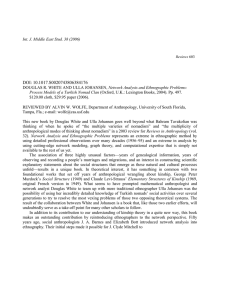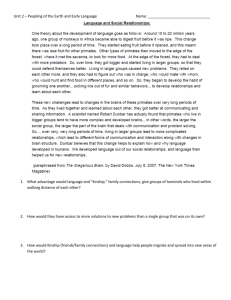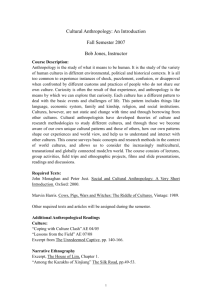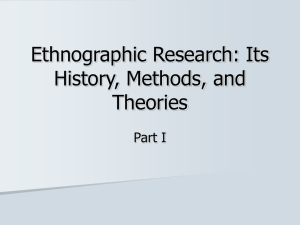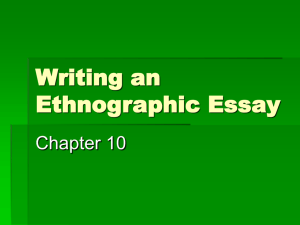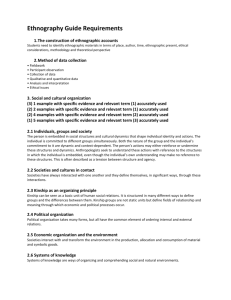IJMES_WolfeReviewFeb22.bak.doc
advertisement
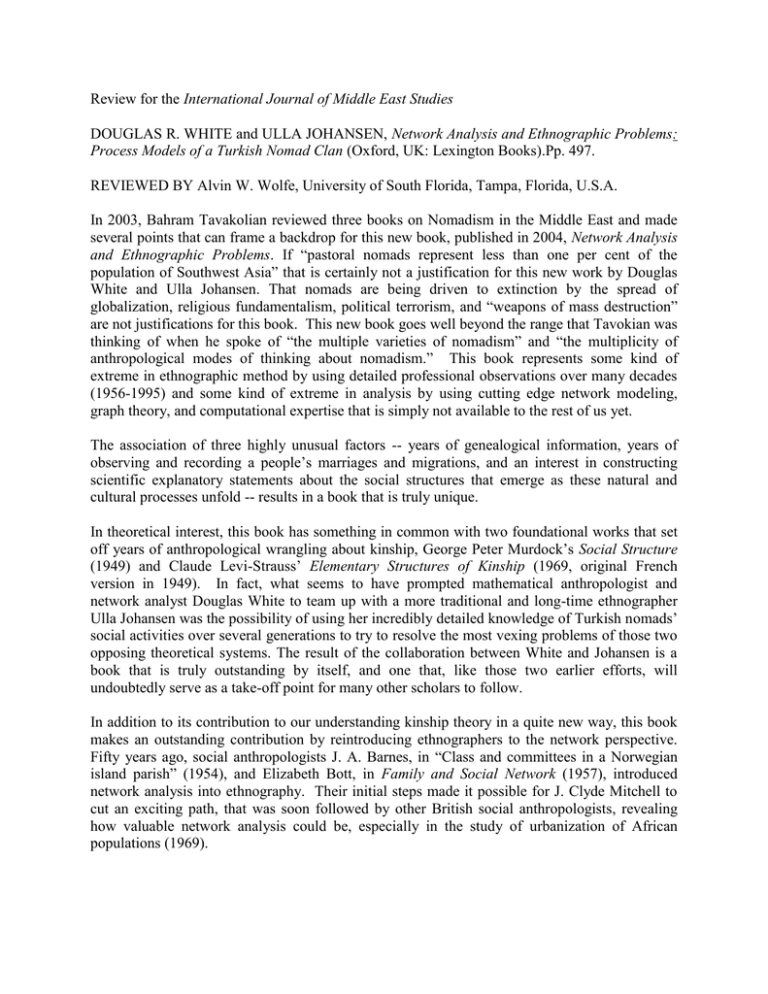
Review for the International Journal of Middle East Studies DOUGLAS R. WHITE and ULLA JOHANSEN, Network Analysis and Ethnographic Problems: Process Models of a Turkish Nomad Clan (Oxford, UK: Lexington Books).Pp. 497. REVIEWED BY Alvin W. Wolfe, University of South Florida, Tampa, Florida, U.S.A. In 2003, Bahram Tavakolian reviewed three books on Nomadism in the Middle East and made several points that can frame a backdrop for this new book, published in 2004, Network Analysis and Ethnographic Problems. If “pastoral nomads represent less than one per cent of the population of Southwest Asia” that is certainly not a justification for this new work by Douglas White and Ulla Johansen. That nomads are being driven to extinction by the spread of globalization, religious fundamentalism, political terrorism, and “weapons of mass destruction” are not justifications for this book. This new book goes well beyond the range that Tavokian was thinking of when he spoke of “the multiple varieties of nomadism” and “the multiplicity of anthropological modes of thinking about nomadism.” This book represents some kind of extreme in ethnographic method by using detailed professional observations over many decades (1956-1995) and some kind of extreme in analysis by using cutting edge network modeling, graph theory, and computational expertise that is simply not available to the rest of us yet. The association of three highly unusual factors -- years of genealogical information, years of observing and recording a people’s marriages and migrations, and an interest in constructing scientific explanatory statements about the social structures that emerge as these natural and cultural processes unfold -- results in a book that is truly unique. In theoretical interest, this book has something in common with two foundational works that set off years of anthropological wrangling about kinship, George Peter Murdock’s Social Structure (1949) and Claude Levi-Strauss’ Elementary Structures of Kinship (1969, original French version in 1949). In fact, what seems to have prompted mathematical anthropologist and network analyst Douglas White to team up with a more traditional and long-time ethnographer Ulla Johansen was the possibility of using her incredibly detailed knowledge of Turkish nomads’ social activities over several generations to try to resolve the most vexing problems of those two opposing theoretical systems. The result of the collaboration between White and Johansen is a book that is truly outstanding by itself, and one that, like those two earlier efforts, will undoubtedly serve as a take-off point for many other scholars to follow. In addition to its contribution to our understanding kinship theory in a quite new way, this book makes an outstanding contribution by reintroducing ethnographers to the network perspective. Fifty years ago, social anthropologists J. A. Barnes, in “Class and committees in a Norwegian island parish” (1954), and Elizabeth Bott, in Family and Social Network (1957), introduced network analysis into ethnography. Their initial steps made it possible for J. Clyde Mitchell to cut an exciting path, that was soon followed by other British social anthropologists, revealing how valuable network analysis could be, especially in the study of urbanization of African populations (1969). The end of the formal colonial era slowed social anthropological research in Africa in the decades following 1960. Also, changes in the interests of anthropologists in the English-speaking world, such as the reduction of interest in comparative social structures and cultures, coupled with rising interest in qualitative interpretive ethnography, left the field of social network analysis to be developed by sociologists and organizational scientists. Douglas White, however, is one of a small number of anthropologists who developed the mathematical expertise necessary to make a genuine contribution to network analysis of complex systems through combining graph theory, long-term fieldwork and the electronic computation required to deal with masses of quantitative data. These are the skills he brought to this work, putting this book at the cutting edge of network studies, regardless of discipline. While his new theoretical concepts and methodological innovations are used here for studies of social systems where kinship is an important component, they are directly relevant to every complex socio-political and historical situation, from studying the internal workings of local organizations, through all sorts of community and state-level organizations, to network-based multinational, international, and supranational organizations that call out for attention today. So, even those who are not interested in Turkish nomads, per se, may find this book of great value. Whether the reader is interested in kinship, in economics, in politics or history, this book might be considered must reading. However, it isn’t easy reading. Although it is well-written, the subject matter is very complex and multidimensional. It contains many tables and figures that are quite necessary to the textual exposition. It even gives “url” addresses to color-coded figures that are available only on the web, figures so complex that they cannot be understood without the color coding. Something that some readers may not understand is that although most graphic illustrations appear in only two dimensions, graph theory is designed to explain multidimensional problems. Any network is, potentially, multidimensional, a network of ten nodes having potentially 90 dimensions, a network of 100 nodes having, potentially, 9,900 dimensions. Human social systems are complex multidimensional systems. If we are to understand them, we must use the appropriate tools. Analyzing only a few dimensions of a multidimensional situation can be genuinely misleading, and it certainly will not yield much understanding of the whole. Network Analysis and Ethnographic Problems begins with an introduction to network analysis in relation to ethnography, providing a succinct history of network thinking including very recent developments in various disciplines about network topology and dynamics. The authors point out that “taking a network path to coding and analysis” in ethnography leads to the ability to understand the emergence of social structural phenomena that would otherwise remain unobserved. Another distinctive feature of this book is the formality with which the authors present their ideas and findings. In the introductory chapter, for example, they present four propositions, about network theory and emergence, with which are associated specific hypotheses that are supported or not by observation and analysis. The first of these is, “Networks have structural properties (local and global) that have important feedback on behavior and cognition”(p. 8). Clearly, that proposition is important not just to kinship, marriage, lineages and clans, but to a much broader range of phenomena. Associated Hypothesis 1.1, for example, about the effect on individual actors of scale-free phenomena in social networks, is shown to be supported by comparisons among networks of food webs and internet webs, networks of physicists and mathematicians, biotech networks, interactions among proteins, and so forth. Although the reader will learn much about the Aydinli nomads in Southeast Turkey, their lineages, clans and marriage preferences and observed patterns, this book is pointedly not just about those things but, as its title states, it is about ethnographic problems. Chapter 2, “Problems of Analysis,” put it clearly: “How shall we ask questions that might unfold a whole theory-net of interesting and useful findings, ones that articulate with other theory-nets and research programs, and what shall be the types of definitions that bring a subject into a clear perspective?”(p. 59). Fortunately, the authors provide a twenty-five page glossary, organized in categories such as ethnography and sociology, networks and graph theory, kinship and social organization, complexity theory, etc. This reviewer found the glossary indispensable, and appreciates also the sections suggesting further readings found at the end of each chapter. These certainly add to the value of the book as a teaching tool. The authors provide much evidence for their overview statement that “long-term field research has changed the face of anthropology” (p.407). In distinguishing between phenomena that are easily observable and those phenomena that are generated through processes of interaction over periods of time they show the need for new concepts, such as “structural cohesion,” that can help fill the gap, as they say, “between social structure and social organization,” and more importantly, “provide a link to the theory of complex phenomena that emerges through interaction”(p.407). One quotation from their concluding chapter summarizes well, or at least better than this reviewer could do, the kinds of innovations this book makes: “It is this very multiplicity of interactive levels and variables that provides a conceptual foundation for the study of social cohesion through the formal definitions and analysis of marital relinking (Chapters 2 and 5), structural endogamy (analyzed in Chapter 6), and changes in bicomponent or exocohesive structure (Chapters 9 and 10) over time. We show how to use the study of changing practices to investigate emergent or changing rules, groups, and norms”(p. 408). Unfortunately, some readers of this review will be put off by the many neologisms –“relinking,” “bicomponent” and “exocohesive” among them. But the careful reader of the entire book comes to see the necessity of most of these, to capture the meaning of phenomena generated by interactions that have not previously been included as theoretical concepts. In fact, this particular reader feels that the authors probably should have used some new words to express the expanded kinds of “cohesiveness” that they refer to. I would feel more comfortable using something closer to “integration” than “cohesiveness” for some of these measurable qualities. Serious scholars of Middle Eastern Studies and of anthropology generally will have to read the book and come to their own conclusions about this. White and Johansen have produced what could be the most important book in anthropology in fifty years. There is nothing like it. Clearly, they hope that their use of these several methodological and theoretical innovations applied to a Turkish nomad clan will stimulate others to undertake similar analyses of whatever societies or social groups they study. To foster that, White and Johansen make careful reference throughout the book to sources where the rest of us can find information on how to use data such as those on which their analyses are based and where we can find the analytic programs they have used. They have done their part. It is now up to us. References cited Barnes, John A. 1954. Class and committees in a Norwegian Island parish. Human Relations 7(1):39-58. Bott, Elizabeth. 1957. Family and Social Network; Roles, Norms, and External Relationships in Ordinary Urban Families. London: Tavistock. Levi-Strauss, Claude. 1969. The Elementary Structures of Kinship. Boston: Beacon Press. Mitchell, J. Clyde, ed.. 1969. Social Networks in Urban Situations: Analyses of Personal Relationships in Central African Towns. Manchester, U.K.: Manchester University Press. Murdock, George P. 1949. Social Structure. New York: McMillan Press. Tavakolian, Bahram. 2003. Multiplicities of nomadism and varieties of anthropological theory. Reviews in Anthropology 32:297-314.
